The nutritionists of the YaELO (Yaeks) clinic developed the Japanese woman, or Japanese diet. The principle of the technique is based on the use of low-calorie food for 7-14 days. Before embarking on a strict diet, experts recommend mental preparation - the weight loss system requires strict adherence to all the rules of the method. This system for getting rid of excess weight is characterized by a long event: it lasts 4 weeks. Despite its high effectiveness, the diet can harm the body, especially if there are contraindications.

Weight loss principle
The Japanese diet is designed for 7, 14 or 13 days. Proper weight loss is achieved by using foods high in protein. Foods high in carbohydrates and fats are excluded from the diet. The technique is considered "salt-free". The first stage of weight loss is accompanied by the normalization of metabolic processes in the body, the elimination of toxins. The fat burning process starts in 2-3 days.
It is impossible to deviate from the regime - the diet is strictly prescribed. Due to the lack of adequate carbohydrates in the dishes, the duration of the diet should not exceed 14 days. The appearance of side effects requires immediate cessation of diet therapy which is the reason for contacting a medical institution. The use of vitamins and minerals is encouraged during weight loss, the complex is chosen individually. It will take up to a month to quit the diet.
Nutrition rules

Dishes made from approved foods can fill you up quickly. This happens because they contain the main "building" component - protein. Carbohydrates and fats enter the body in small quantities. Fiber is found in fresh vegetables and fruits, and their use is not limited. Soluble dietary fiber contributes to the normal functioning of the digestive system. Antioxidants involved in metabolism are found in green tea and natural coffee.
A menu specially selected for each day provides the essential nutrients for the body.
The drinking regimen must be carefully observed: a minimum of 1. 5 liters of liquid must be consumed per day. Dishes cannot contain salt, sugar and hot spices. The number of meals is limited: a maximum of 3 times a day. You can't have a snack.
Experts recommend giving up sweets and junk food in advance - this will help avoid breakdowns. It is recommended to reduce portions.
Approved and Prohibited Products
The list of products allowed for consumption is strictly limited. For 14 days, the daily menu can include:
- meat and poultry products;
- fish;
- on the;
- vegetables;
- results;
- freshly squeezed natural juices;
- dairy products;
- still tea and mineral water.
Vegetables, fruits and greens you can eat:
- zucchini;
- carrot;
- egg production;
- cabbage;
- apples;
- pineapple;
- pears;
- kiwi;
- pomelo;
- citrus fruits (lemons, oranges).
Bread and rusks should be rye. Treats lean meat (lean beef, chicken, turkey) and fish (hake, blue whiting, cod). Eggs are allowed, but in small quantities. Drinks (green tea, weak natural coffee, boiled water) should not contain sweeteners. You can drink tomato juice and low-fat kefir (1%). Olive oil is included in the diet.
Prohibited foods must be completely excluded from the menu. These include:
- fatty meats and fish;
- vegetable oils;
- salt and sugar;
- fast food;
- flour products;
- smoked and cooked sausages;
- semi-finished products and canned food;
- sweets and pastries;
- starchy foods (vegetables, cereals);
- alcohol and tobacco products;
- sauces, marinades.
Vegetables and fruits:
- Cherries;
- cherries;
- Garnet;
- persimmon;
- tangerines;
- mango;
- figs;
- passion fruit;
- grape.
Dried fruits:
- prunes;
- raisin;
- dried apricots;
- dates.
The Japanese rarely eat dairy products, as they are often lactose intolerant, so they are not included in the diet.
Potato chips, sweet popcorn and salty taste need to be excluded from the diet. Semolina, barley and millet groats are not used to cook foods that promote fat burning.
Prohibited flour products:
- pancakes;
- dumplings;
- vareniki;
- spaghetti (noodles);
- pancakes;
- pasta;
- wheat bread;
- muffin.

Confectionery (sweets, cookies, pastries, rolls, cakes, marshmallows, halva, preserves, jam) is strictly prohibited. Condiments (spices, mayonnaise, kettle) are not added to dishes. Any dairy products (sour cream, cheese, fermented baked milk, full-fat milk, cream) are prohibited.
Meat and sausages:
- pork;
- mutton;
- Ham;
- cooked pork;
- Salo;
- smoked sausages;
- boiled, boiled, dry-cured smoked sausages.
Dried, smoked and dried fish should be removed from the diet immediately. Poultry meat is eaten only in cooked form. Do not use chocolate, ghee and butter. Alcoholic beverages and tobacco products are excluded 2-3 weeks before weight loss. High-carbonated sweet drinks (lemonade, kvass) are still replaced by mineral water.
Dried fruit compotes, jelly are not included in the drinking diet. It is also necessary to refrain from juices of cherry, apple, pomegranate, grape and orange. Nectar is prepared from pineapple and tomatoes, they are drunk in small quantities.
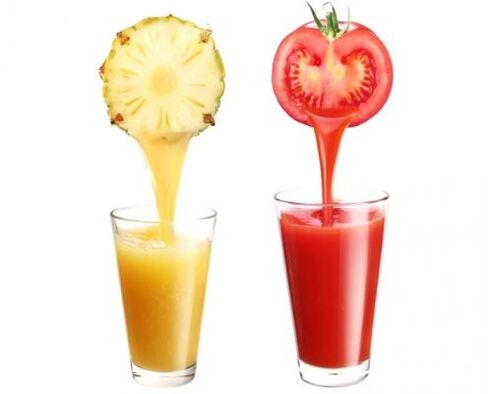
Types of Japanese diet
There are 3 types of Japanese diet. They differ in the number of days:
- 7 days;
- 13 days;
- 14 days.
The diet regimen must be followed regardless of the type of technique.
14 day diet
The salt-free dilution system was designed for 2 weeks. During this period, fat cells are gradually released and burned. In the first 3 days, the body is cleansed. During this period, experts recommend drinking plenty of fluids: boiled water and green tea accelerate the flushing out of the remaining toxins. By convention, the diet can be divided into 2 stages, each lasting 7 days. At the first stage, kefir is included in the menu. Dishes are steamed, frying and sautéing are ignored.
Diet for 7 days
The sweetest technique was designed for a week. During this period, you may not lose more than 3-4 kilograms. The menu is strict, the products are strictly limited and cannot be replaced. During the period of weight loss, restructuring occurs, when the body becomes accustomed to the new diet, therefore, experts consider this system to be the least effective. Traditional Japanese cuisine may be prepared with approved ingredients in the menu. They cannot be supplemented. For people who are planning to lose weight according to Japanese women, nutritionists recommend choosing the "light" option.
Diet for 13 days
This type of operating principle is different from the previous two. The serving weight does not exceed 200 g, liquid is consumed when thirsty. Food intake - simultaneously for 13 days. Compliance with all detox nutrition rules is mandatory. In less than 2 weeks, the intestines are completely cleansed. The process of burning fat occurs gradually, therefore, in problem areas, the skin retains its elasticity. The spent energy supply is replenished with protein foods.
Daily diet scheme
Diluted dishes are perfectly adapted to European cuisine and contain no exotic ingredients. The approximate menu was designed for 7 days, on the 8th day it is repeated. He is allowed to change drinks: green tea, kefir - to replace coffee - with tomato juice. The daily norm of products, if necessary, is divided into two parts depending on the number of days (with weekly weight loss).
Diet scheme (for 14 days):
- chicken fillet - 1 kg;
- fish fillet - 2 kg;
- lean beef - 1 kg;
- biscuits or rye bread - 0. 5 kg;
- chicken eggs - 20 pcs;
- white cabbage - 2 pcs;
- zucchini and / or eggplant - 1 kg;
- carrots - 2. 5-3 kg;
- fruit (unsweetened) - 1 kg;
- lemons (large) - 2 pcs;
- kefir (low fat) - 1 l;
- olive oil - (cold pressed) - 0. 5 l;
- tomato juice (homemade) - 1 liter;
- natural coffee (grain or powder) - 1 pack;
- green tea (large leaf) - 1 pack.
The rate of water consumption depends on the age and weight of the person.
The set of food for three meals a day is sufficient. Boiled water can be substituted for non-carbonated mineral water. The minimum amount of liquid per day is 1. 5 liters.
Detailed daily menu plan (per day):
- For breakfast (8. 00) - a cup of weak natural coffee. No need to add cream, sugar, condensed milk. For lunch (13. 00) - stewed chopped cabbage in its own juice by adding a small amount of olive oil, 2 hard boiled eggs and 250 ml of tomato juice. For dinner (18. 00) - fish (boneless fillet 200 g), steamed or boiled.
- Breakfast - coffee without milk and sugar, a slice of rye bread. Lunch - stewed cabbage with olive oil and steamed fish fillets (boiled) (100 g). Dinner - boiled beef pulp (100 g) and 250 ml of low-fat kefir.
- For breakfast - a cup of weak natural coffee and rye crouton. For lunch - vegetable stew made from eggplant or zucchini. For dinner - a salad of fresh white cabbage, seasoned with oil. You can eat 2 eggs and 200 g of boiled lean beef (pulp).
- Breakfast - mashed raw carrots, lemon juice. Lunch - boiled boneless fish fillet (200 g), 250 ml of tomato juice. Dinner - unlimited fruit.
- For breakfast - raw mashed carrots, lemon juice. For lunch - boiled boneless fish fillet (200 g), a glass of tomato juice. For dinner - fruit of any quantity.
- Breakfast - coffee or green tea without sugar. Lunch - 0. 50 boiled chicken (skinless breast or thighs), fresh vegetable salad (carrots and cabbage) with a little oil. Dinner - boiled chicken eggs (2 pcs), Fresh grated carrot salad with butter.
- For breakfast - green tea without sugar. For lunch - stewed or boiled beef pulp. For dinner - any dish (except dinner for 3 nights).
The menu can be displayed schematically. Experts recommend placing a sheet with a drawing in a prominent place.
The right way out of the diet
Dietary nutrition type must be adhered to 2-4 weeks after the diet. During weight loss, the body becomes accustomed to small portions and low-calorie foods. It is necessary to avoid the diet in order to maintain normal weight and optimal functioning of the digestive tract. It is recommended to return to the normal diet gradually: foods rich in carbohydrates are added a little every day. The duration of the release is at least 14 days.
Meals should be fractional, portion weight should not be increased. Foods that contain a small amount of calories and the energy stored in the process of losing weight should be at the forefront of the diet. It is not recommended to reduce the amount of protein foods consumed (chicken eggs, poultry and fish). In the menu, fats and carbohydrates are gradually introduced. Salt and sugar can be added in micro-doses. The drink should be plentiful, not to consume more than 2 liters per day.
During the period you leave the diet, cereals are allowed to be eaten for breakfast. Oatmeal, buckwheat and rice groats are cooked in water. Vegetables and fruits are eaten raw in any quantity. It is best to give preference to sweet and sour apple varieties. Snacks are introduced between the main meals: a glass of kefir or rice cakes. Rye bread is added to whole grains or yeast-free bread.
Pasta and confectionery, baked goods and snacks are not included in the diet.
Cost of diet
Products approved for use during weight loss are in the average price category.
Advantages and disadvantages
The Japanese technique for losing weight has several advantages and disadvantages. Benefits include:
- efficiency;
- availability;
- cleansing at the same time to lose weight;
- detailed menu;
- Three meals a day;
- increased muscle tone.
The efficiency is due to the rapid process of fat burning, the result is visible after 7 days. The products are available to everyone and can be purchased at any store. No need to pre-calculate calories, the menu is clearly written. Food is taken 3 times a day, the diet is hearty, so the feeling of hunger is rare. Cleansing the body helps to normalize metabolic processes. Due to the high protein content in foods, muscle structure is strengthened.
The disadvantages are:
- unbalanced diet;
- deficiency of vitamins and minerals;
- lack of heart breakfast;
- the need to leave the rules of the diet;
- short-term weight loss;
- contraindications.
An unbalanced diet and non-compliance with the ratio of fats, proteins and carbohydrates increases the risk of side effects. Decreased natural protective reactions, deterioration of the condition of nails and hair occur against a background of lack of vitamins in the body. The right way out of the diet prevents the development of stressful situations that can lead to rapid weight gain.
Contraindications and harms

The diet is only suitable for healthy people. Before you lose weight, you need to undergo an examination and consult a nutritionist. Violations include:
- pregnancy at any time;
- breastfeeding;
- ulcers of the stomach and duodenum;
- corrosive damage to the digestive system;
- kidney and liver pathology, including failure;
- anemia;
- gallbladder disease;
- infectious etiological diseases;
- pathology of the cardiovascular system;
- hypovitaminosis;
- diabetes;
- blood pressure surge;
- increase chronic diseases;
- gout.
The diet is not suitable for the elderly and adolescents. Non-observance of the general rules of the technique increases the risk of side effects. In the early days, a disturbance of nausea and stool (constipation or diarrhea) may appear. Excessive flatulence or colic is accompanied by digestive upset. Bad breath, heartache and belching are seen. Headaches occur against a background of complete rejection of sugar.
Neurosis and sleep disorders develop for the same reason. Due to the lack of fat, a bitter taste appears in the mouth. Appearance may worsen: the skin becomes pale and dry. Nutritional deficiencies lead to joint pain.
Diet recipes
Dietary meals are added to the menu on departure. You can diversify your diet with salads, first and second courses. Self-made desserts with a low sugar content improve brain function and can be eaten after 14-15 days.
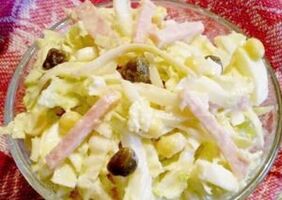
"Hope" diet salad includes the following ingredients:
- potatoes - (2 pcs. );
- milk sausages - (2 pcs);
- chicken breast - (250 g);
- pickled cucumber - (1 pc. );
- greens;
- salt;
- olive oil - (1 tbsp).
Cut boiled potatoes, boiled chicken and sausages into cubes. Place the mass in a deep bowl and season with salt. Then cut cucumber into strips and chopped greens.
Season the salad with olive oil (first press).
Cabbage salad:
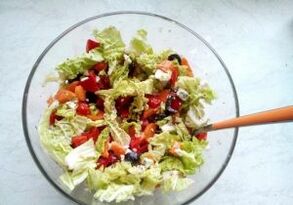
- Peking cabbage - (250 g);
- fresh cucumbers and tomatoes - (250 g);
- chili pepper - (1 pc. );
- hard cheese - (150 g);
- salt;
- olives (1/2 can);
- olive oil.
Rub the Chinese cabbage leaves into small pieces with your hands. Cucumbers and tomatoes are cut into large pieces. Cut chili (half a vegetable) in a blender. Mix all ingredients, salt and season with oil. Garnish the salad with grated cheese and olives on top.
The first courses are taken at lunchtime. For easier digestion, purified soups are prepared. Spinach and celery soup:
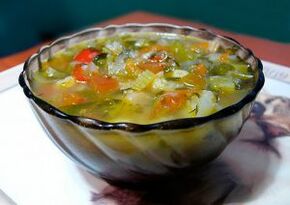
- lemon - (1 pc. );
- tomatoes - (2 pcs. );
- spinach - (200 g);
- celery - (stem, 2 pcs. );
- greens;
- vegetable broth - (1. 5 l);
- salt;
- olive oil - (1 tbsp. l. ).
Pour olive oil into a preheated pan. Finely chop the celery stem and sauté in oil. In a separate saucepan, bring the broth to a boil, add the chopped spinach and simmer for 5–7 minutes. Peel the tomatoes and grind them in a blender. Add tomato paste with spinach. Salt the broth, add frying. Cook for 15-20 minutes. Add a little lemon juice and chopped herbs to the finished soup.
Mushroom cream soup:
- mushrooms - (8 pcs. );
- potatoes - (2 pcs. );
- zucchini - (300 g);
- carrots - (1 pc);
- onion - (1 pc. );
- weak meat broth - (1 l);
- flour - (1 tbsp. l. );
- olive oil - (2 tbsp. l. );
- cream - (1 tbsp. l. ).
Cut the cooked vegetables into small cubes and grate them in a blender. Bring the broth to a boil. Fry flour until golden brown, add to broth, add vegetable puree. Simmer the soup over low heat until thickened, then salt, add cream and garnish with herbs. The first course is served with rye croutons.
Beef stew with vegetables:
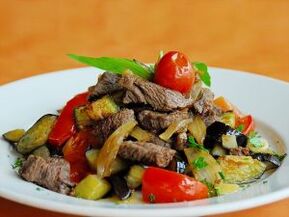
- beef - (500 g);
- olive oil - (3 tbsp. l. );
- potatoes - (200 g);
- carrots - (1 pc);
- bell pepper - (1 pc. );
- onions - (1 pc. ).
Dip the onion, bell pepper and grated carrots in half rings in olive oil. Boil the beef until half cooked, cool and cut into small bars. Put the meat on fried vegetables, salt. Place cut potatoes into strips on top. Salt again. Pour meat broth into vegetables. Cook the dish over low heat for 25-30 minutes.
Indian manti is a diet dish, which is prepared in 2 steps. Ingredients for the dough:
- flour - (1. 5 cups);
- hot water - (1 glass);
- salt.
Dissolve salt in warm water. Pour flour on the work surface, depress it. Pour salted water into portions, gradually draining the elastic dough. Cover it with a towel and leave it for 15-20 minutes.
While the dough fits, you need to prepare the dressing. Essential components:
- mushrooms - (6-8 pcs. );
- carrots - (1 pc);
- green onions (4-5 feathers);
- zucchini - (400 g);
- olive oil - (2 tbsp. l. );
- tomato paste - (2 tbsp. l. );
- chicken fillet - (400 g).
Cut the mushrooms, zucchini and carrots into small cubes. Boil the chicken fillet and chop it into strips. Fry onions in oil and tomato paste, gradually adding carrots, zucchini, mushrooms and meat. Pour 150-200 ml of water into the frying pan and simmer the vegetables until tender.
Roll out the dough into thin strips and coat each with oil. Cut the strips into squares (10x10 cm), stacked on top of each other. The dough is steamed in a pressure cooker or slow cooker for 15-20 minutes. The dough "columns" are laid out on a dish, poured with vegetable sauce and fried with herbs.
Results and reviews
In 2 weeks, you can lose weight 8-9 kg. Most women and men who have lost weight using this technique speak positively about it.
First review, female, 36 years old
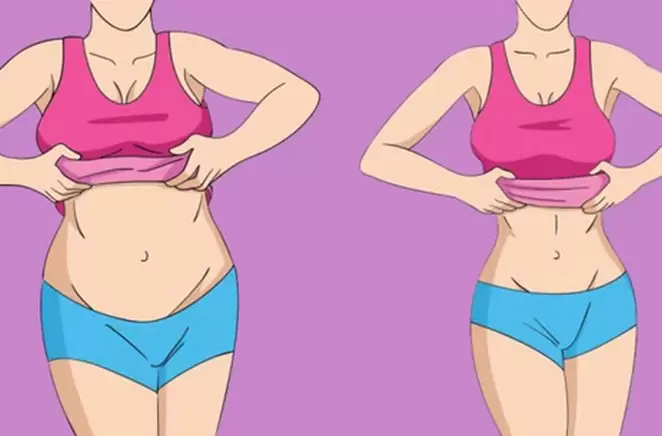
I started recovering in adolescence, I tried a lot of diets - they didn’t help. I went to a nutritionist, underwent a medical examination, ate separately, always calculated calories, fixed fasting days, and in 5 months I was only able to lose 2 kilograms. A friend advised on a Japanese fat burning system, I failed to lose 7 kg in two weeks. I decided to give it a try.
Medical examination showed no violations. The nutritionist gave detailed recommendations on the diet. The system does not require large material investments. On the doctor's advice, she painted the menu in detail, attached the sheet to the refrigerator. In the first 3 days I almost fell through: the parts looked small, there was always a feeling of hunger. On the 4th day it was easier, I tried to chew food longer and drink more liquid.
The second stage of losing weight flew by fast. I cooked on the machine: I remembered the ingredients of the dishes and their weight. The food looked satisfying, the hunger practically disappeared. There were no side effects, except a short-term headache on day 3. The dietitian explained that this is due to a lack of sugar. I left the diet for 20 days. I liked the food at the exit, so I abandoned sweet, fatty, salty and smoked foods altogether. I am happy with the result: in 2 weeks I lost 10, 5 kg. In six months I will use this weight loss system again.
Second review, female, 28
I learned about the technique 2 years ago. At that time she weighed 107 kg, with an increase of 164, the figure is crucial. There were health problems, and I was not happy with the appearance. Her friends could not advise on an effective diet, so she decided to consult a specialist. The doctor recommended to try to lose weight using the Japanese weight loss system. The long grocery list was intimidating at first, but the nutritionist calmed down and explained the diet in detail.
For 7 days he took 5 kg. The dishes from the menu are hearty, I ate one portion. Initially, there was slight dizziness and slight disturbances in the intestines. The side effects went away on their own. She took food at the same time. The second step of losing weight was easy: brightness, appearance and general well-being were improved. Thanks to the diet, I quit smoking and gave up alcohol altogether. 13 kg went up during the release period. For the last 5 years I have been eating properly, I have been swimming and jogging, my previous weight is not back.
















































































